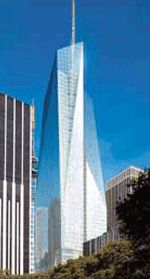The greenest skyscraper in New York.
Skyscraper owner Douglas Durst and chief architect Robert Fox hope their building will become the most environmentally friendly in the world. All stages of the building’s construction were modified in such a way that the high-rise developers could obtain the coveted rating — “Platinum” (the best possible). This status is awarded by the U.S. Green Building Council.
During the design and construction of a building, various engineering techniques are used to reduce resource consumption. Internal partitions are made of glass and provide better penetration of light into the building, reducing the load on artificial lighting. Roof water collectors (even though the building is located in Manhattan) affect the building’s water needs. And parking racks for bicycles on the ground floor near the entrance to the building, according to the developers, should encourage people working in it to refuse to use a car.
Robert Fox: “We received one rating point from the American Council on Environmental Protection clean buildings only thanks to bicycle parking racks. The building does not have a garage at all.”
“If you are building buildings today that are not green, then you are building a building that is obviously outdated,” Darst said during a tour of the construction site where the 28th floor of the skyscraper is currently being built. He stated that all environmental innovations that were used in the project, in monetary terms, amount to from 2% to 4% of the cost of the entire construction (about 1.2 billion dollars). According to his forecasts, these “green” investments should pay off within 2–4 years due to energy savings. Durst believes that his family business (The Durst Organization), which has been involved in the construction of buildings in Manhattan since 1915, will pass on to his descendants as properties that have a high status and performance compared to other buildings.

The co-owner of the building is Bank of America, which will occupy a significant part of the building for offices. Since the building is initially constructed using new materials and the latest technologies, the need for future modifications will be minimized, which will also result in savings.
The tower is designed with a special water supply system: roof water collectors are integrated with the water supply systems for sanitary purposes, collecting condensate from the building’s air conditioning system and using steam supplied by ConEdison. As a result, the water thus collected is used to flush toilets and to feed evaporative panels to cool the building, which together significantly reduces the building’s water bills.
The building covers an area of two square acres, and New York typically receives about four feet of rain in a year. Imagine: two square acres filled with water four feet high! And all this will go to work.
Darst hopes that the “green” technologies used in the Bank of America building will serve as an example for others to follow in the construction of buildings around the world. He noted: “Currently we are just learning to understand what is hidden behind the concept of a “green” building.
And in this project we spent much more time and money on design than usual, however, we are confident that our efforts will soon pay off.”
Bank of America is also interested in making sure the building is environmentally friendly and efficient to maintain. The chairman of the board of the bank, Ken Lewis, expressed the wish that their future building would evoke only the most positive emotions and associations, therefore, when designing the facility, “The Durst Organization” tried to satisfy the needs of the main owner as much as possible.
On all floors of the building The ceilings are 9 feet 6 inches high, which is 2.74 m, and floor-to-ceiling exterior glazing is used throughout to allow light to flow into the building. All internal partitions are also made of glass, so a person whose office is located in the very center of the building will always be aware of what the weather is like outside. Heat gains from solar radiation during the cold season will reduce the load on the heating system.

“There is a term that can be used to describe what we are doing when we build this skyscraper,” — said Fox. “The term “biophilia” was coined by Harvard University biology scientist Edward O. Wilson to describe the human desire to be closer to nature.”
Wilson argues that as humans, the desire to connect with nature is ingrained in our DNA and affects our overall well-being. “People working at their desks all day will definitely want to see what’s going on outside… is it raining, snowing, or is it sunny?” – Fox noted.
The building was designed with a dimmable lighting system. According to the project, a light sensor will be installed in each room, which will increase or decrease the ceiling lighting depending on the intensity of outdoor lighting and the required need. Based on research, the building’s builders concluded that comfortable workplaces, high ceilings and comfortable lighting can increase people’s productivity by 10-15%.
Green innovation is not just for the people who will work in the building. “For New York, our building will be like a huge air filter,” Darst said. – “We will supply four times more air into the building than the minimum air exchange requirements specified in city regulations, so excess air removed from the building will also be purified.
Higher volumes of air exchange will reduce the likelihood of “sick building syndrome” ” (sick building syndrome), which appears due to imperfect filtration systems for air supplied to the building.
Durst also noted that people who will work in the new building will breathe air that is 95% purified, rather than 35% purified as in conventional buildings. Supply air ducts will be located in the raised floor, and a thermostat will be placed in each office and in each room, with which you can regulate the air supply to the room.
Such a solution will save energy spent on cooling the supplied air, because the air supplied to the lower zone of the room must be cooled much less than if the air was supplied to the room in the upper zone, where in this case it would be prevented from being properly distributed throughout the room by the “thermal cushion” from the air located on the ceiling, as well as the heat generated by the lighting devices. Cold air is heavier than warm air, and as it enters the room from below, it gradually warms up and is evenly distributed throughout the room, rising up.
“The full-length ventilation duct system was invented by the ancient Romans,” Fox said. – “And in Europe this solution has been used for more than 20 years, but in the USA it is only now beginning to be used.”
Construction of the building should be completed in 2008. Its creators hope that when the tower is commissioned, it will be a “neutral” building in relation to its environmental impact and will be part of the solution to prevent global drowning on the planet. “This is not just calculations…” Darst concluded. – “We also cannot be 100% sure that the building will be absolutely neutral, but we are working in this direction.”
Victoria Golovina, AZ
